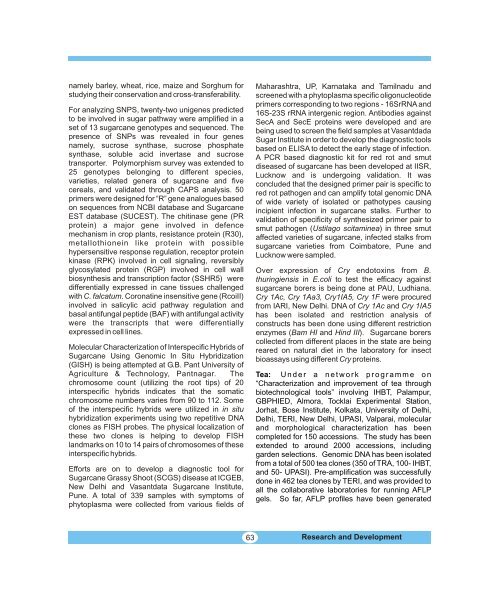ANNUAL REPORT - Department of Biotechnology
ANNUAL REPORT - Department of Biotechnology
ANNUAL REPORT - Department of Biotechnology
You also want an ePaper? Increase the reach of your titles
YUMPU automatically turns print PDFs into web optimized ePapers that Google loves.
namely barley, wheat, rice, maize and Sorghum for<br />
studying their conservation and cross-transferability.<br />
For analyzing SNPS, twenty-two unigenes predicted<br />
to be involved in sugar pathway were amplified in a<br />
set <strong>of</strong> 13 sugarcane genotypes and sequenced. The<br />
presence <strong>of</strong> SNPs was revealed in four genes<br />
namely, sucrose synthase, sucrose phosphate<br />
synthase, soluble acid invertase and sucrose<br />
transporter. Polymorphism survey was extended to<br />
25 genotypes belonging to different species,<br />
varieties, related genera <strong>of</strong> sugarcane and five<br />
cereals, and validated through CAPS analysis. 50<br />
primers were designed for “R” gene analogues based<br />
on sequences from NCBI database and Sugarcane<br />
EST database (SUCEST). The chitinase gene (PR<br />
protein) a major gene involved in defence<br />
mechanism in crop plants, resistance protein (R30),<br />
metallothionein like protein with possible<br />
hypersensitive response regulation, receptor protein<br />
kinase (RPK) involved in cell signaling, reversibly<br />
glycosylated protein (RGP) involved in cell wall<br />
biosynthesis and transcription factor (SSHR5) were<br />
differentially expressed in cane tissues challenged<br />
with C. falcatum. Coronatine insensitive gene (RcoiII)<br />
involved in salicylic acid pathway regulation and<br />
basal antifungal peptide (BAF) with antifungal activity<br />
were the transcripts that were differentially<br />
expressed in cell lines.<br />
Molecular Characterization <strong>of</strong> Interspecific Hybrids <strong>of</strong><br />
Sugarcane Using Genomic In Situ Hybridization<br />
(GISH) is being attempted at G.B. Pant University <strong>of</strong><br />
Agriculture & Technology, Pantnagar. The<br />
chromosome count (utilizing the root tips) <strong>of</strong> 20<br />
interspecific hybrids indicates that the somatic<br />
chromosome numbers varies from 90 to 112. Some<br />
<strong>of</strong> the interspecific hybrids were utilized in in situ<br />
hybridization experiments using two repetitive DNA<br />
clones as FISH probes. The physical localization <strong>of</strong><br />
these two clones is helping to develop FISH<br />
landmarks on 10 to 14 pairs <strong>of</strong> chromosomes <strong>of</strong> these<br />
interspecific hybrids.<br />
Efforts are on to develop a diagnostic tool for<br />
Sugarcane Grassy Shoot (SCGS) disease at ICGEB,<br />
New Delhi and Vasantdata Sugarcane Institute,<br />
Pune. A total <strong>of</strong> 339 samples with symptoms <strong>of</strong><br />
phytoplasma were collected from various fields <strong>of</strong><br />
Maharashtra, UP, Karnataka and Tamilnadu and<br />
screened with a phytoplasma specific oligonucleotide<br />
primers corresponding to two regions - 16SrRNA and<br />
16S-23S rRNA intergenic region. Antibodies against<br />
SecA and SecE proteins were developed and are<br />
being used to screen the field samples at Vasantdada<br />
Sugar Institute in order to develop the diagnostic tools<br />
based on ELISA to detect the early stage <strong>of</strong> infection.<br />
A PCR based diagnostic kit for red rot and smut<br />
diseased <strong>of</strong> sugarcane has been developed at IISR,<br />
Lucknow and is undergoing validation. It was<br />
concluded that the designed primer pair is specific to<br />
red rot pathogen and can amplify total genomic DNA<br />
<strong>of</strong> wide variety <strong>of</strong> isolated or pathotypes causing<br />
incipient infection in sugarcane stalks. Further to<br />
validation <strong>of</strong> specificity <strong>of</strong> synthesized primer pair to<br />
smut pathogen (Ustilago scitaminea) in three smut<br />
affected varieties <strong>of</strong> sugarcane, infected stalks from<br />
sugarcane varieties from Coimbatore, Pune and<br />
Lucknow were sampled.<br />
Over expression <strong>of</strong> Cry endotoxins from B.<br />
thuringiensis in E.coli to test the efficacy against<br />
sugarcane borers is being done at PAU, Ludhiana.<br />
Cry 1Ac, Cry 1Aa3, Cry1IA5, Cry 1F were procured<br />
from IARI, New Delhi. DNA <strong>of</strong> Cry 1Ac and Cry 1IA5<br />
has been isolated and restriction analysis <strong>of</strong><br />
constructs has been done using different restriction<br />
enzymes (Bam HI and Hind III). Sugarcane borers<br />
collected from different places in the state are being<br />
reared on natural diet in the laboratory for insect<br />
bioassays using different Cry proteins.<br />
Tea: Under a network programme on<br />
“Characterization and improvement <strong>of</strong> tea through<br />
biotechnological tools” involving IHBT, Palampur,<br />
GBPHIED, Almora, Tocklai Experimental Station,<br />
Jorhat, Bose Institute, Kolkata, University <strong>of</strong> Delhi,<br />
Delhi, TERI, New Delhi, UPASI, Valparai, molecular<br />
and morphological characterization has been<br />
completed for 150 accessions. The study has been<br />
extended to around 2000 accessions, including<br />
garden selections. Genomic DNA has been isolated<br />
from a total <strong>of</strong> 500 tea clones (350 <strong>of</strong> TRA, 100- IHBT,<br />
and 50- UPASI). Pre-amplification was successfully<br />
done in 462 tea clones by TERI, and was provided to<br />
all the collaborative laboratories for running AFLP<br />
gels. So far, AFLP pr<strong>of</strong>iles have been generated<br />
63 Research and Development

















